Structural Control on the Formation of Pb-Zn Deposits: An Example from the Pyrenean Axial Zone
Abstract
:1. Introduction
2. Geological Setting
3. Structural Analysis of Three Pb-Zn Districts in the Bossòst Anticlinorium
3.1. District of Bentaillou-Liat-Urets
3.1.1. Bentaillou Area
3.1.2. Liat Area
3.1.3. Urets Area
3.2. District of Margalida-Victoria-Solitaria
3.2.1. Margalida Area
3.2.2. Victoria-Solitaria Areas
3.3. District of Pale Bidau-Argut-Pale de Rase
4. Comparison with the Pierrefitte Anticlinorium: Pierrefitte and Arre-Anglas-Uzious Districts
4.1. Pierrefitte District
4.2. Arre-Anglas-Uzious District
5. Ore Petrology and Microstructures
6. Discussion
6.1. Types of Pb-Zn Mineralizations in the PAZ
6.2. Genetic Model of PAZ Pb-Zn Deposits Formation Linked to Regional Geology
6.3. Is Pb-Zn Deposits Emplacement Sedimentary- or Structurally-Controlled?
7. Conclusions
Author Contributions
Funding
Acknowledgments
Conflicts of Interest
References
- Wilkinson, J.J. Sediment-Hosted Zinc-Lead Mineralization: Processes and perspectives. Treatise Geochem. 2013, 13, 219–249. [Google Scholar]
- Leach, D.L. Sediment-hosted lead-zinc deposits: A global perspective. Econ. Geol. 2005, 100, 561–607. [Google Scholar]
- Moore, D.W.; Young, L.E.; Modene, J.S.; Plahuta, J.T. Geologic setting and genesis of the Red Dog zinc-lead-silver deposit, western Brooks Range, Alaska. Econ. Geol. 1986, 81, 1696–1727. [Google Scholar] [CrossRef]
- Kelley, K.D.; Jennings, S. A special issue devoted to barite and Zn-Pb-Ag deposits in the Red Dog district, Western Brooks Range, northern Alaska. Econ. Geol. 2004, 99, 1267–1280. [Google Scholar] [CrossRef]
- Hazarika, P.; Upadhyay, D.; Mishra, B. Contrasting geochronological evolution of the Rajpura-Dariba and Rampura-Agucha metamorphosed Zn-Pb deposit, Aravalli-Delhi Belt, India. J. Asian Earth Sci. 2013, 73, 429–439. [Google Scholar] [CrossRef]
- Lawrence, L.J. Polymetamorphism of the sulphide ores of Broken Hill, NSW, Australia. Miner. Depos. 1973, 8, 211–236. [Google Scholar] [CrossRef]
- Gibson, G.M.; Nutman, A.P. Detachment faulting and bimodal magmatism in the Palaeoproterozoic Willyama Supergroup, south-central Australia; keys to recognition of a multiply deformed Precambrian metamorphic core complex. J. Geol. Soc. 2004, 161, 55–66. [Google Scholar] [CrossRef]
- Hobbs, B.E.; Walshe, J.L.; Ord, A.; Zhang, Y.; Carr, G.C. The Broken Hill orebody: A high temperature, high pressure scenario. AGSO Rec. 1998, 2, 98–103. [Google Scholar]
- Walters, S.; Bailey, A. Geology and mineralization of the Cannington Ag-Pb-Zn deposit: An example of Broken Hill-Type mineralization in the eastern succession, Mount Isa Inlier, Australia. Econ. Geol. 1998, 93, 1307–1329. [Google Scholar] [CrossRef]
- Webster, A.E. The Structural Evolution of the Broken Hill Pb-Zn-Ag Deposit, New South Wales, Australia. Ph.D. Thesis, University of Tasmania, Hobart, Australia, 2004. [Google Scholar]
- Bodon, S.B. Paragenetic relationships and their implications for ore genesis at the Cannington Ag-Pb-Zn deposit, Mount Isa inlier, Queensland, Australia. Econ. Geol. 1998, 93, 1463–1488. [Google Scholar] [CrossRef]
- Haydon, R.C.; Mcconachy, G.W. The stratigraphic setting of Pb-Zn-Ag mineralization at Broken Hill. Econ. Geol. 1987, 82, 826–856. [Google Scholar] [CrossRef]
- Yalikun, Y.; Xue, C.; Symons, D.T.A. Paleomagnetic age and tectonic constraints on the genesis of the giant Jinding Zn-Pb deposit, Yunnan, China. Miner. Depos. 2018, 53, 245–259. [Google Scholar] [CrossRef]
- Shi, J.X.; Yi, F.H.; Wen, Q.D. The rock-ore characteristics and mineralisation of Jinding lead-zinc deposit, Lanping. J. Yunnan Geol. 1983, 2, 179–195. [Google Scholar]
- Wang, J.B.; Li, C.Y.; Chen, X. A new genetic model for the Jinding lead-zinc deposit. Geol. Explor. Non Ferr. Met. 1992, 1, 200–206. (In Chinese) [Google Scholar]
- Leach, D.L.; Song, Y.C.; Hou, Z.Q. The world-class Jinding Zn–Pb deposit: Ore formation in an evaporite dome, Lanping Basin, Yunnan, China. Miner. Depos. 2017, 52, 281–296. [Google Scholar] [CrossRef]
- Kyle, J.R.; Li, N. Jinding: A giant tertiary sandstone-hosted Zn–Pb deposit, Yunnan, China. SEG Newsl. 2002, 50, 1–9. [Google Scholar]
- Chi, G.; Xue, C.; Qing, H.; Xue, W.; Zhang, J.; Sun, Y. Hydrodynamic analysis of clastic injection and hydraulic fracturing structures in the Jinding Zn-Pb deposit, Yunnan, China. Geosci. Front. 2012, 3, 73–84. [Google Scholar] [CrossRef]
- Xue, C.; Zeng, R.; Liu, S.; Chi, G.; Qing, H.; Chen, Y.; Yang, J.; Wang, D. Geologic, fluid inclusion and isotopic characteristics of the Jinding Zn-Pb deposit, western Yunnan, South China: A review. Ore Geol. Rev. 2007, 31, 337–359. [Google Scholar] [CrossRef]
- Chi, G.; Qing, H.; Xue, C. An overpressured fluid system associated with the giant sandstone-hosted Jinding Zn-Pb deposit, western Yunnan, China Chapter. In Mineral Deposit Research: Meeting the Global Challenge; Mao, J., Bierlein, F.P., Eds.; Springer: Berlin, German, 2005; pp. 93–96. [Google Scholar]
- Zwart, H.J. The Geology of the Central Pyrenees. Leidse Geol. Meded. 1979, 50, 1–74. [Google Scholar]
- Mezger, J.E.; Passchier, C.W. Polymetamorphism and ductile deformation of staurolite-cordierite schist of the Bossòst dome: Indication for Variscan extension in the Axial Zone of the central Pyrenees. Geol. Mag. 2003, 140, 595–612. [Google Scholar] [CrossRef]
- Denèle, Y.; Laumonier, B.; Paquette, J.-L.; Olivier, P.; Gleizes, G.; Barbey, P. Timing of granite emplacement, crustal flow and gneiss dome formation in the Variscan segment of the Pyrenees. Geol. Soc. Lond. Spec. Publ. 2014, 405, 265–287. [Google Scholar] [CrossRef]
- Bois, J.P.; Pouit, G. Les minéralisations de Zn (Pb) de l’anticlinorium de Pierrefitte: Un exemple de gisements hydrothermaux et sédimentaires associés au volcanisme dans le Paléozoïque des Pyrénées centrales. Bureau Rech. Geol. Min. 1976, 6, 543–567. (In French) [Google Scholar]
- Pouit, G.; Fortuné, J.-P. Métallogénie comparée des Pyrénées et du Sud du Massif-central. In Proceedings of the 26ème Congrès Géologique International, Paris, France, 7–17 July 1980; p. 61. (In French). [Google Scholar]
- Fert, D. Un Aspect de la Métallogénie du Zinc et du Plomb Dans l’Ordovicien des Pyrénées Centrales: Le District de Sentein (Ariège, Haute-Garonne). Ph.D. Thesis, University Pierre Marie Curie, Paris, France, 1976. [Google Scholar]
- Pouit, G. Différents Modèles de Mineralisations «Hydrothermale Sédimentaire», à Zn (Pb) du Paléozoïque des Pyrénees Centrales. Miner. Depos. 1978, 13, 411–421. (In French) [Google Scholar] [CrossRef]
- Pouit, G. Les minéralisations Zn-Pb exhalatives sédimentaires de Bentaillou et de l’anticlinorium paléozoïque de Bosost (Pyrénées ariégeoises, France). Chron. Rech. Min. 1986, 485, 3–16. (In French) [Google Scholar]
- Pujals, I. Las Mineralizaciones de Sulfuros en el Cambro-Ordovicico de la Val d’Aran (Pirineo Central, Lérida). Ph.D. Thesis, University Autónoma Barcelona, Barcelona, Spain, 1992. [Google Scholar]
- Cardellach, E.; Phillips, R.; Ayora, C. Metamorphosed stratiform sulphides of the Liat area, Central Pyrenees, Spain. Inst. Min. Metall. Trans. 1982, 91, 90–95. (In Spanish) [Google Scholar]
- Cardellach, E. Estudio microscópico de las mineralizaciones de Pb-Zn de Liat, Baguergue y Montoliu. Acta Geol. Hisp. 1977, 12, 120–122. (In Spanish) [Google Scholar]
- Alonso, J.L. Deformaciones Sucesivas en el Area Comprendida Entre Liat y el Puerto de Orla—Control Estructural de los Depositos de Sulfuros (Valle de Aran, Pirineos Centrales). Master’s Thesis, University Oviedo, Oviedo, Spain, 1979. (In Spanish). [Google Scholar]
- Nicol, N. Etude Structurale des Minéralisations Zn-Pb du Paléozoïque du Dôme de Pierrefitte (Hautes-Pyrénées). Goniométrie de Texture Appliquée aux Minéraux Transparents et Opaques. Ph.D. Thesis, University Orléans, Orléans, France, 1997. (In French). [Google Scholar]
- García-Sansegundo, J.; Martin-Izard, A.; Gavaldà, J. Structural control and geological significance of the Zn-Pb ores formed in the Benasque Pass area (Central Pyrenees) during the post-late Ordovician extensional event of the Gondwana margin. Ore Geol. Rev. 2014, 56, 516–527. [Google Scholar] [CrossRef]
- Marcoux, E. Isotope du plomb et paragénèses métalliques, traceurs de l’histoire des gites mineraux. Bur. Rech. Geol. Min. 1986, 117, 1–289. (In French) [Google Scholar]
- Zwart, H.J. Metamorphic history of the Central Pyrenees, Part II, Valle de Aran. Leidse Geol. Meded. 1963, 28, 321–376. [Google Scholar]
- Kleinsmiede, W.F.J. Geology of the Valle de Aran (Central Pyrenees). Leidse Geol. Meded. 1960, 25, 129–245. [Google Scholar]
- Cochelin, B.; Lemirre, B.; Denèle, Y.; De Saint Blanquat, M.; Lahfid, A.; Duchêne, S. Structural inheritance in the Central Pyrenees: The Variscan to Alpine tectonometamorphic evolution of the Axial Zone. J. Geol. Soc. Lond. 2017, 175, 16. [Google Scholar] [CrossRef]
- De Sitter, L.U.; Zwart, H.J. Tectonic development in supra and infra-structures of a mountain chain. In Structure of the Earth’s Crust and Deformation of Rocks; Det Berlingske Bogtrykkeri: Copenhagen, Denmark, 1960; Volume 18, pp. 248–256. [Google Scholar]
- Carreras, J.; Capellà, I. Tectonic levels in the Palaeozoic basement of the Pyrenees: A review and a new interpretation. J. Struct. Geol. 1994, 16, 1509–1524. [Google Scholar] [CrossRef]
- Carreras, J.; Druguet, E. Framing the tectonic regime of the NE Iberian Variscan segment. Geol. Soc. Lond. Spec. Publ. 2014, 405, 249–264. [Google Scholar] [CrossRef]
- Cochelin, B. Champ de déformation du socle Paléozoïque des Pyrénées. Ph.D. Thesis, Université Toulouse 3 Paul Sabatier, Toulouse, France, 2016. (In French). [Google Scholar]
- Mezger, J.E.; Gerdes, A. Early Variscan (Visean) granites in the core of central Pyrenean gneiss domes: Implications from laser ablation U-Pb and Th-Pb studies. Gondwana Res. 2016, 29, 181–198. [Google Scholar] [CrossRef]
- Pouget, P. Hercynian tectonometamorphic evolution of the Bosost dome (French Spanish Central Pyrenees). J. Geol. Soc. Lond. 1991, 148, 299–314. [Google Scholar] [CrossRef]
- Mezger, J.E. Comparison of the western Aston-Hospitalet and the Bossòst domes: Evidence for polymetamorphism and its implications for the Variscan tectonic evolution of the Axial Zone of the Pyrenees. J. Virtual Explor. 2005, 19, 1–19. [Google Scholar] [CrossRef]
- Mezger, J.E.; Schnapperelle, S.; Rölke, C. Evolution of the Central Pyrenean Mérens fault controlled by near collision of two gneiss domes. Hallesches Jahrb. 2012, 34, 11–29. [Google Scholar]
- Carreras, J. Zooming on Northern Cap de Creus shear zones. J. Struct. Geol. 2001, 23, 1457–1486. [Google Scholar] [CrossRef]
- BRGM International Report: Les Gisements de Pb-Zn Français (Situation en 1977); BRGM: Orléans, France, 1984; pp. 1–278. (In French)
- Ovejero Zappino, G. Mineralizaciones Zn-Pb ordovícicas del anticlinorio de Bossost. Yacimientos de Liat y Victoria. Valle de Arán. Pirineo (España). Bol. Geol. Min. 1991, 102, 356–377. (In Spanish) [Google Scholar]
- Castroviejo Bolibar, R.; Serrano, F.M. Estructura y metalogenia del campo filoniano de Cierco (Pb-Zn-Ag), en el Pirineo de Lérida. Bol. Geol. Min. 1983, 1983, 291–320. (In Spanish) [Google Scholar]
- Aerden, D.G.A. Kinematics of orogenic collapse in the Variscan Pyrenees deduced from microstructures in porphyroblastic rocks from the Lys-Caillaouas massif. Tectonophysics 1994, 238, 139–160. [Google Scholar] [CrossRef]
- Barrère, P.; Bouquet, C.; Debroas, E.J.; Pelissonnier, H.; Peybernes, B.; Soulé, J.C.; Souquet, P.; Ternet, Y. Arreau. In BRGM Geological Map 1/50,000 with Note; BRGM: Orléans, France, 1984; p. 60. (In French) [Google Scholar]
- Clin, M.; Taillefer, F.; Pouchan, P.; Muller, A. Bagnères de Luchon. In BRGM Geological Map 1/50,000 with Note; BRGM: Orléans, France, 1989; p. 78. (In French) [Google Scholar]
- Lavigne, J. Pic de Mauberme. In BRGM Geological Map 1/50,000 with Note; BRGM: Orléans, France, 1972; p. 24. (In French) [Google Scholar]
- García-Sansegundo, J.; Merino, J.R.; Santisteban, R.R.; Leyva, F. Canejan-Vielha Mapa geologico 1:50,000. Inst. Geol. Min. Espana 2013, 1, 66. (In French) [Google Scholar]
- Garcia-Sansegundo, J.; Alonso, J.L. Stratigraphy and structure of the southeastern Garona Dome. Geodin. Acta 1989, 3, 127–134. [Google Scholar] [CrossRef]
- Cugerone, A.; Cenki-Tok, B.; Chauvet, A.; Le Goff, E.; Bailly, L.; Alard, O.; Allard, M. Relationships between the occurrence of accessory Ge-minerals and sphalerite in Variscan Pb-Zn deposits of the Bossost anticlinorium, French Pyrenean Axial Zone: Chemistry, microstructures and ore-deposit setting. Ore Geol. Rev. 2018, 95, 1–19. [Google Scholar] [CrossRef]
- Dubois, C. Mangeuses d’homme: L’épopée des Mines de Bentaillou et de Bulard en Ariège; Privat Edition: Toulouse, France, 2015; p. 320. (In French) [Google Scholar]
- Barrère, P.; Bois, J.-P.; Soulé, J.-C.; Ternet, Y. Argelès-Gazost. In BRGM Geological Map 1/50,000 with Note; BRGM: Orléans, France, 1980; pp. 1–48. (In French) [Google Scholar]
- Nicol, N.; Legendre, O.; Charvet, J. Les minéralisations Zn-Pb de la série paléozoïque de Pierrefitte (Hautes-Pyrénées) dans la succession des évènements tectoniques hercyniens. C. R. Acad. Sci. 1997, 324, 453–460. (In French) [Google Scholar]
- Calvet, P. Etude Structurale et Métallogénique de L’anticlinorium de Pierrefitte: Influence de la Déformation sur les Minéralisations Stratiformes. Ph.D. Thesis, University d’Orléans, Orléans, France, 1988; p. 283. (In French). [Google Scholar]
- Alvarez-Perez, A.; Campa-Vineta, J.A.; Montoriol-Pous, J. Sobre la presencia de gahnita ferrífera en Bossost (Vall D’Aran, Lérida). Acta Geol. Hisp. 1974, 9, 111–113. (In Spanish) [Google Scholar]
- Reyx, J. Relations Entre Tectonique, Métamorphisme de Contact et Concentrations Metalliques dans le Secteur des Anciennes Mines d’Arre et Anglas (Hautes-Pyrénées-Pyrénées atlantiques). Ph.D. Thesis, University Paris VI, Paris, France, 1973; p. 83. (In French). [Google Scholar]
- Scott, R.J.; Meffre, S.; Woodhead, J.; Gilbert, S.E.; Berry, R.F.; Emsbo, P. Development of framboidal pyrite during diagenesis, low-grade regional metamorphism, and hydrothermal alteration. Econ. Geol. 2009, 104, 1143–1168. [Google Scholar] [CrossRef]
- Vernhet, Y. Les Minéralisations Zincifères de l’Ordovicien et du Dévonien du Val d’Orle (District de Sentein, Ariège) et de la région de Fourcaye (Val d’Aran, Espagne). Ph.D. Thesis, University Pierre Marie Curie, Paris, France, 1981; p. 279. (In French). [Google Scholar]
- Windh, J. Saddle Reef and Related Gold Mineralization, Hill End Gold Field, Australia: Evolution of an Auriferous Vein System during Progressive Deformation. Econ. Geol. 1995, 90, 1764–1775. [Google Scholar] [CrossRef]
- Bull, S.W.; Large, R.R. Setting the stage for the genesis of the giant Bendigo ore system. Geol. Soc. Lond. Spec. Publ. 2015, 393, 161–187. [Google Scholar] [CrossRef]
- Zeng, M.; Zhang, D.; Zhang, Z.; Li, T.; Li, C.; Wei, C. Structural controls on the Lala iron-copper deposit of the Kangdian metallogenic province, southwestern China: Tectonic and metallogenic implications. Ore Geol. Rev. 2018, 97, 35–54. [Google Scholar] [CrossRef]
- Cardellach, E.; Alvarez-Perez, A. Interpretación genética de las mineralizaciones de Pb-Zn del Ordovícico Sup. de la Vall de Aran. Acta Geol. Hisp. 1979, 14, 117–120. (In Spanish) [Google Scholar]
- Alvarez-Perez, A.; Campa-Vineta, J.A.; Montoriol-Pous, J. Mineralogénesis de los yacimientos del área de Bossost (Vall d’Aran, Lérida). Acta Geol. Hisp. 1977, 4–6, 123–126. (In Spanish) [Google Scholar]
- Ovejero Zappino, G. Mineralizaciones Zn-Pb del Ordovicico Superior del Valle de Aran (Anticlinorio de Bossost). Pireneo de Lerida (Espana). Bol. Soc. Esp. Mineral. 1987, 10, 35–37. [Google Scholar]
- Munoz, M.; Baron, S.; Boucher, A.; Béziat, D.; Salvi, S. Mesozoic vein-type Pb-Zn mineralization in the Pyrenees: Lead isotopic and fluid inclusion evidence from the Les Argentières and Lacore deposits. C. R. Geosci. 2015, 348, 322–332. [Google Scholar] [CrossRef]
- Militon, C. Métallogénie polyphasée à Zn, Pb, Ba, F et Mg, Fe de ma région de Gèdre-Gavarnie-Barroude (Hautes-Pyrénées). Ph.D. Thesis, University d’Orléans, Orléans, France, 1987. (In French). [Google Scholar]
- Munoz, M.; Boyce, A.J.; Courjault-Rade, P.; Fallick, A.E.; Tollon, F. Multi-stage fluid incursion in the Palaeozoic basement-hosted Saint-Salvy ore deposit (NW Montagne Noire, southern France). Appl. Geochem. 1994, 9, 609–626. [Google Scholar] [CrossRef]
- Pouit, G. Les minéralisations Zn-Pb dans l’Ordovicien des Pyrénées centrales-Etude préliminaire. Rapp. BRGM 1974, 74, 50. (In French) [Google Scholar]
- Pouit, G.; Bois, J.P. Arrens Zn (Pb), Ba Devonian deposit, Pyrénées, France: An exhalative-sedimentary-type deposit similar to Meggen. Miner. Depos. 1986, 21, 181–189. [Google Scholar] [CrossRef]
- Wagner, T.; Schneider, J. Lead isotope systematics of vein-type antimony mineralization, Rheinisches Schiefergebirge, Germany: A case history of complex reaction and remobilization processes. Miner. Depos. 2002, 37, 185–197. [Google Scholar] [CrossRef]
- Marcoux, E.; Moelo, Y. Lead isotope geochemistry and paragenetic study of inheritance phenomena in metallogenesis: Examples from base metal sulfide deposits in France. Econ. Geol. 1991, 86, 106–120. [Google Scholar] [CrossRef]
- Kamona, A.F.; Lévêque, J.; Friedrich, G.; Haack, U. Lead isotopes of the carbonate-hosted Kabwe, Tsumeb, and Kipushi Pb-Zn-Cu sulphide deposits in relation to Pan African orogenesis in the Damaran-Lufilian Fold Belt of Central Africa. Miner. Depos. 1999, 34, 273–283. [Google Scholar] [CrossRef]
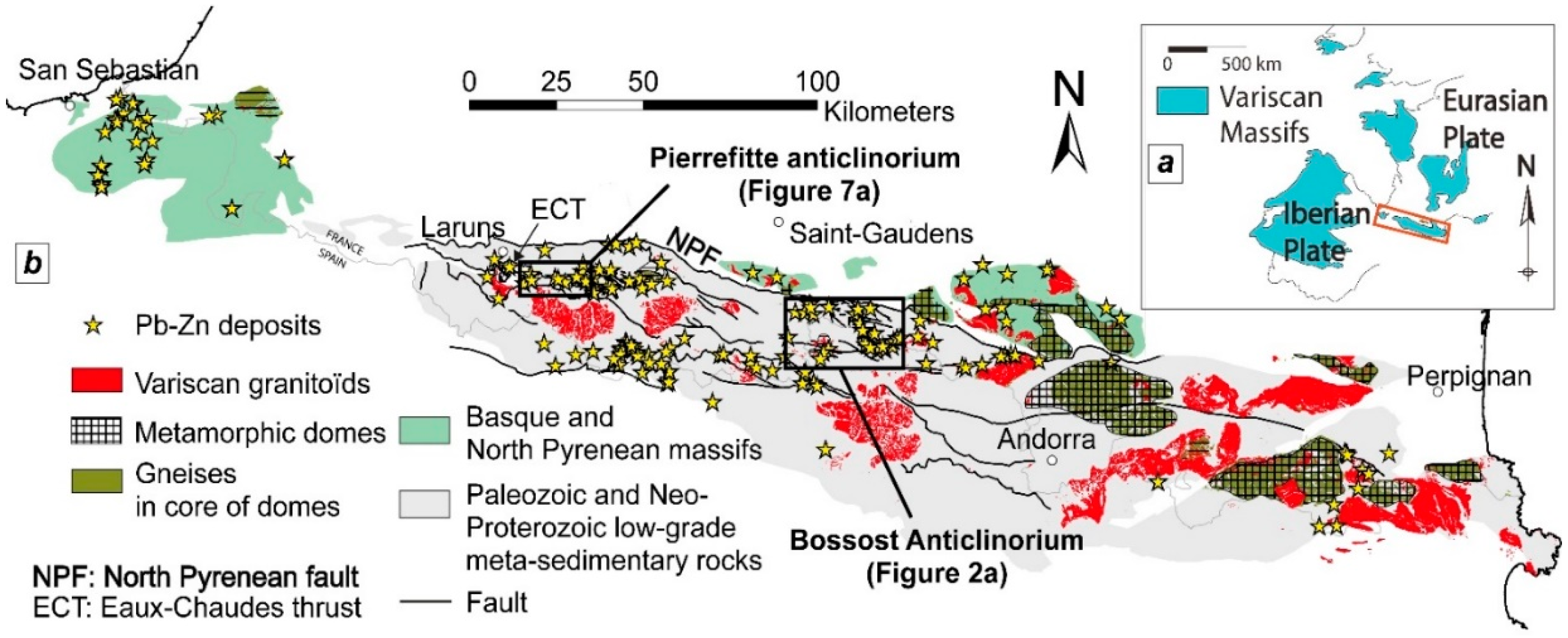
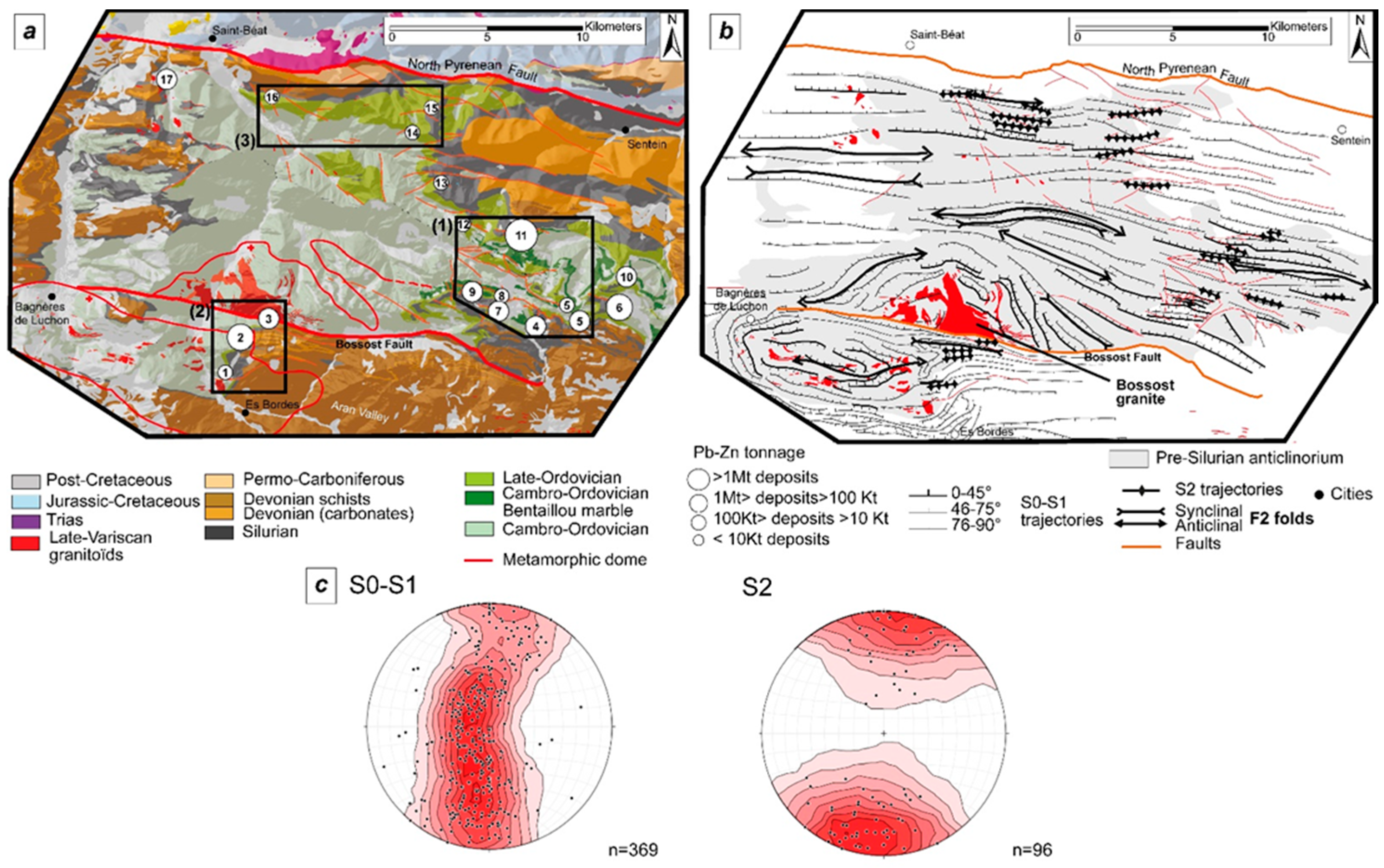
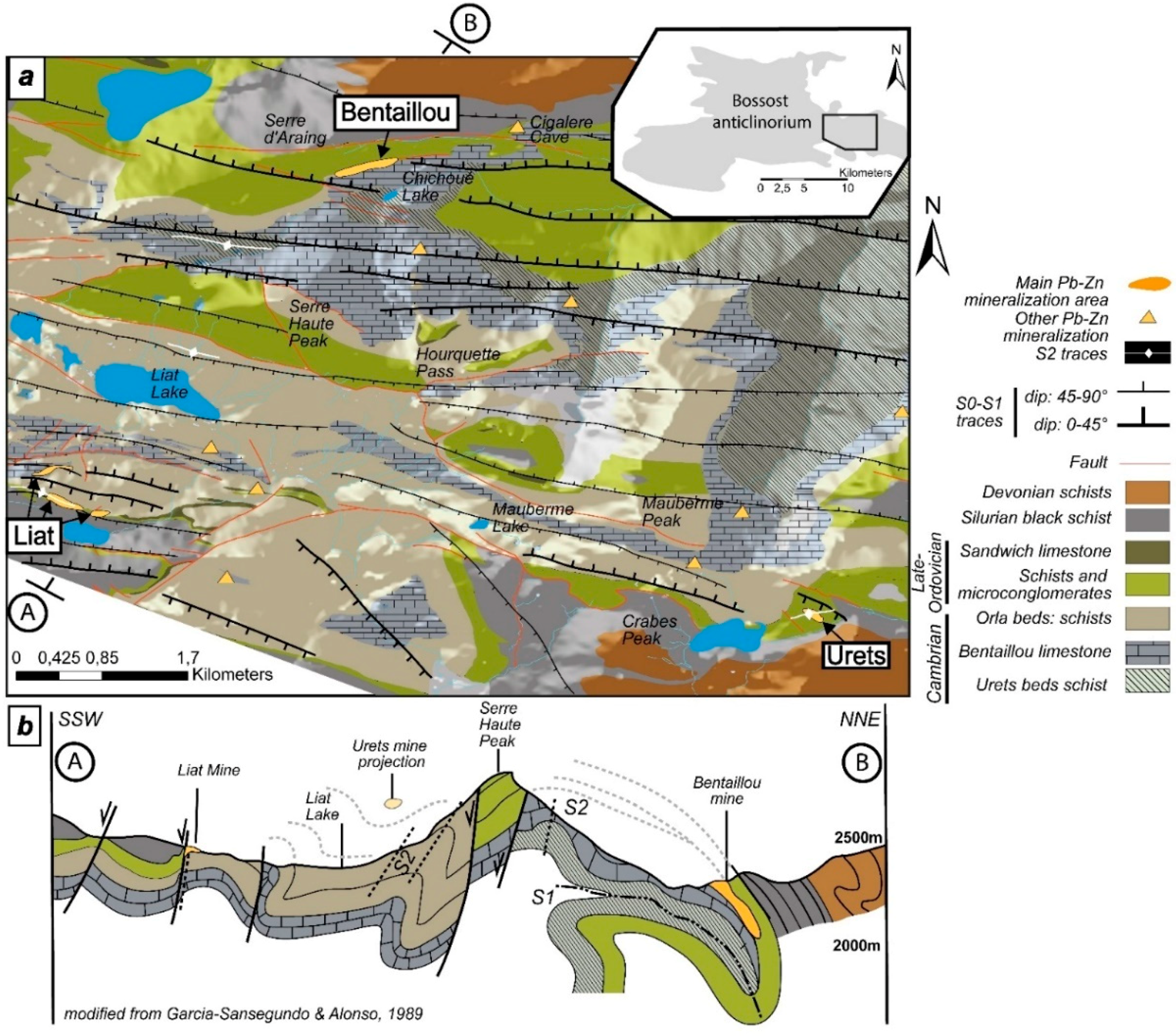
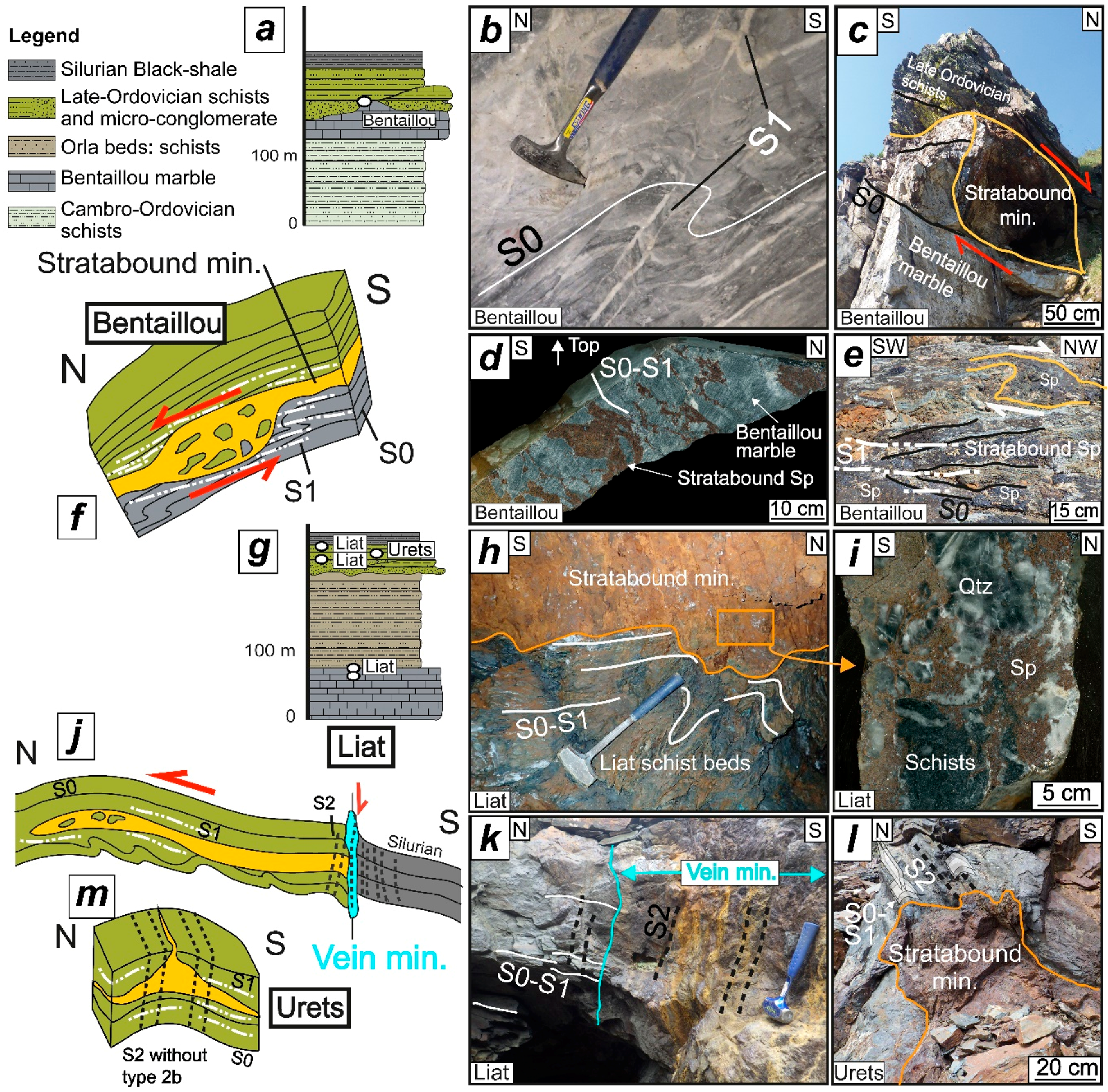
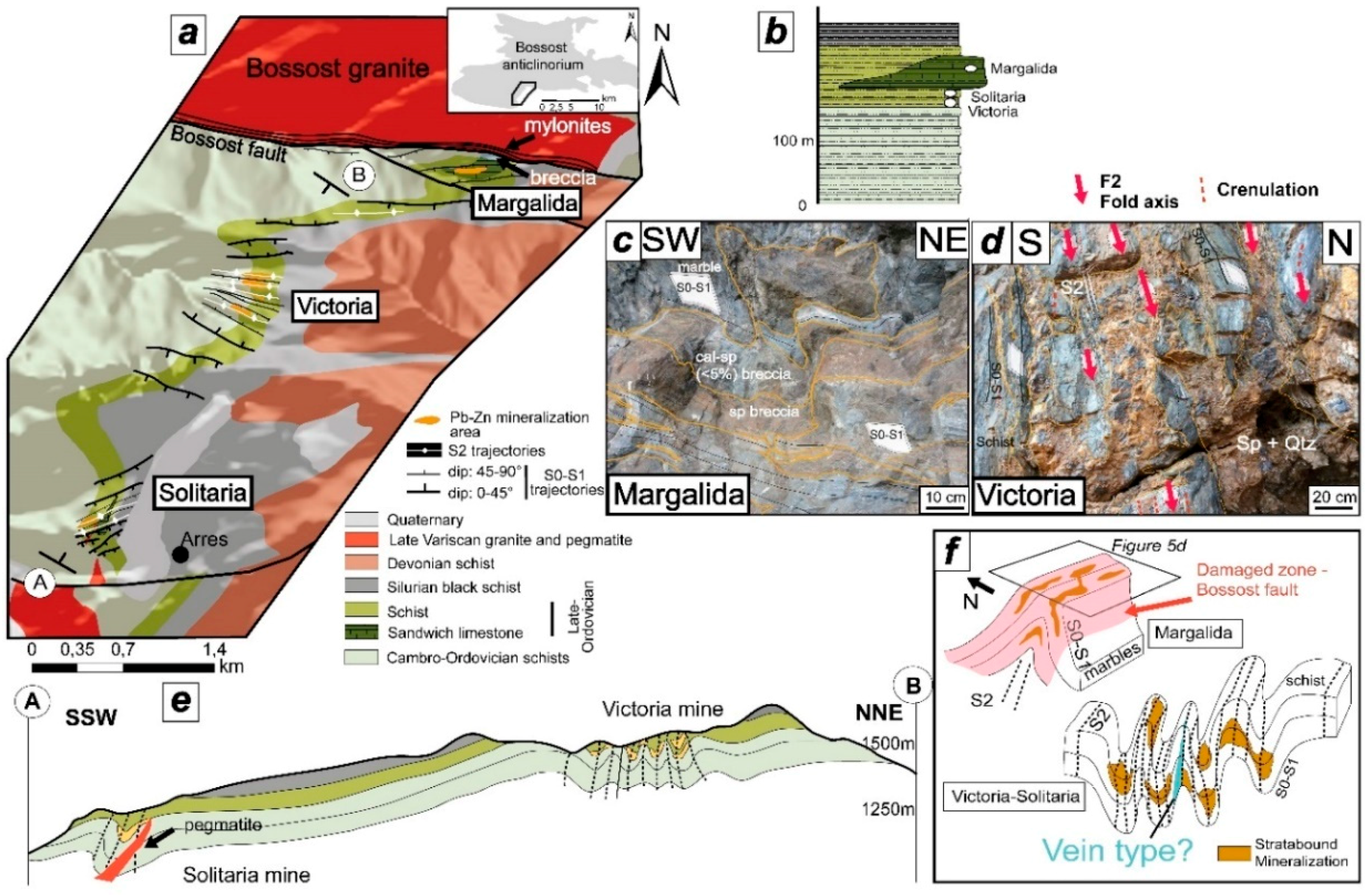

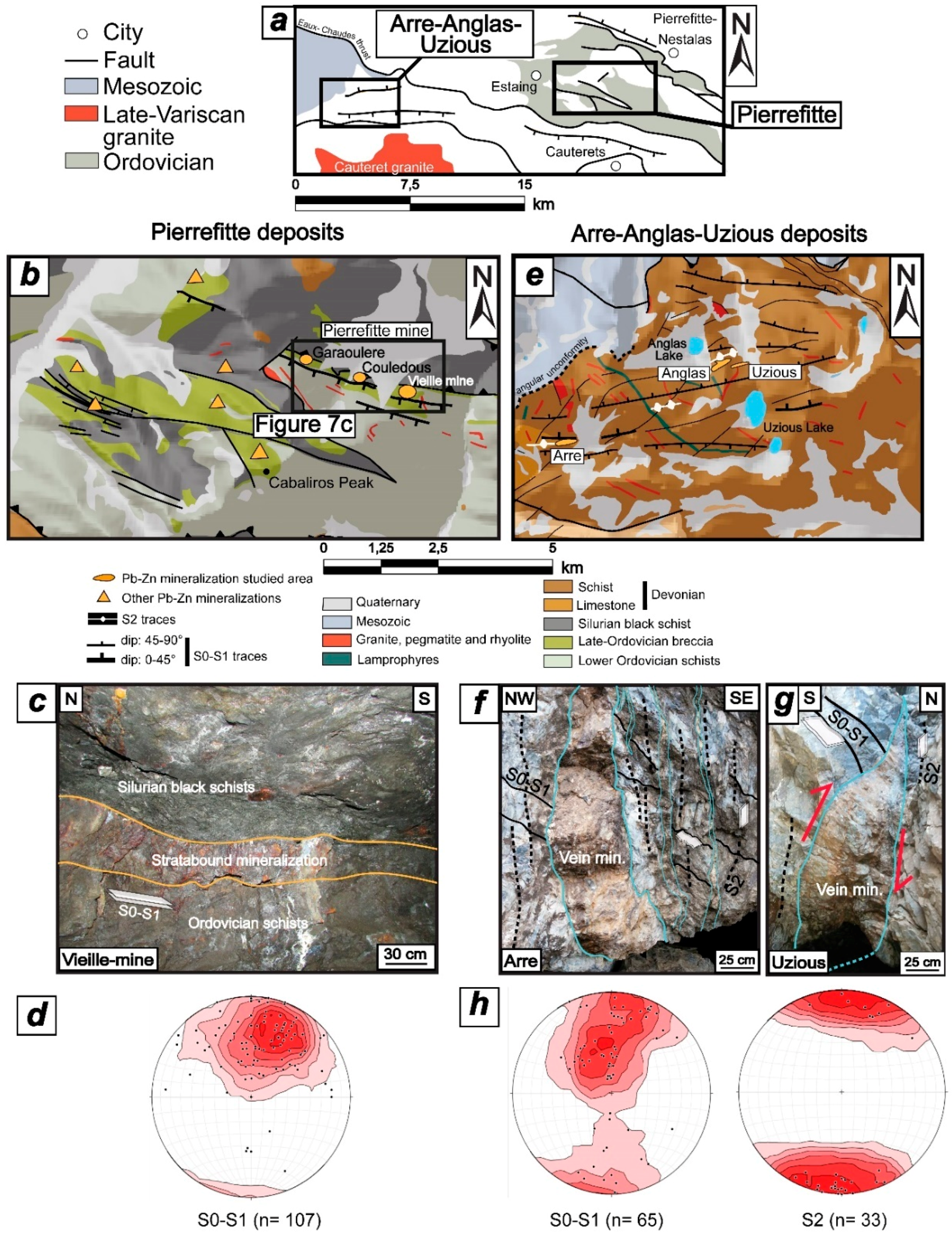
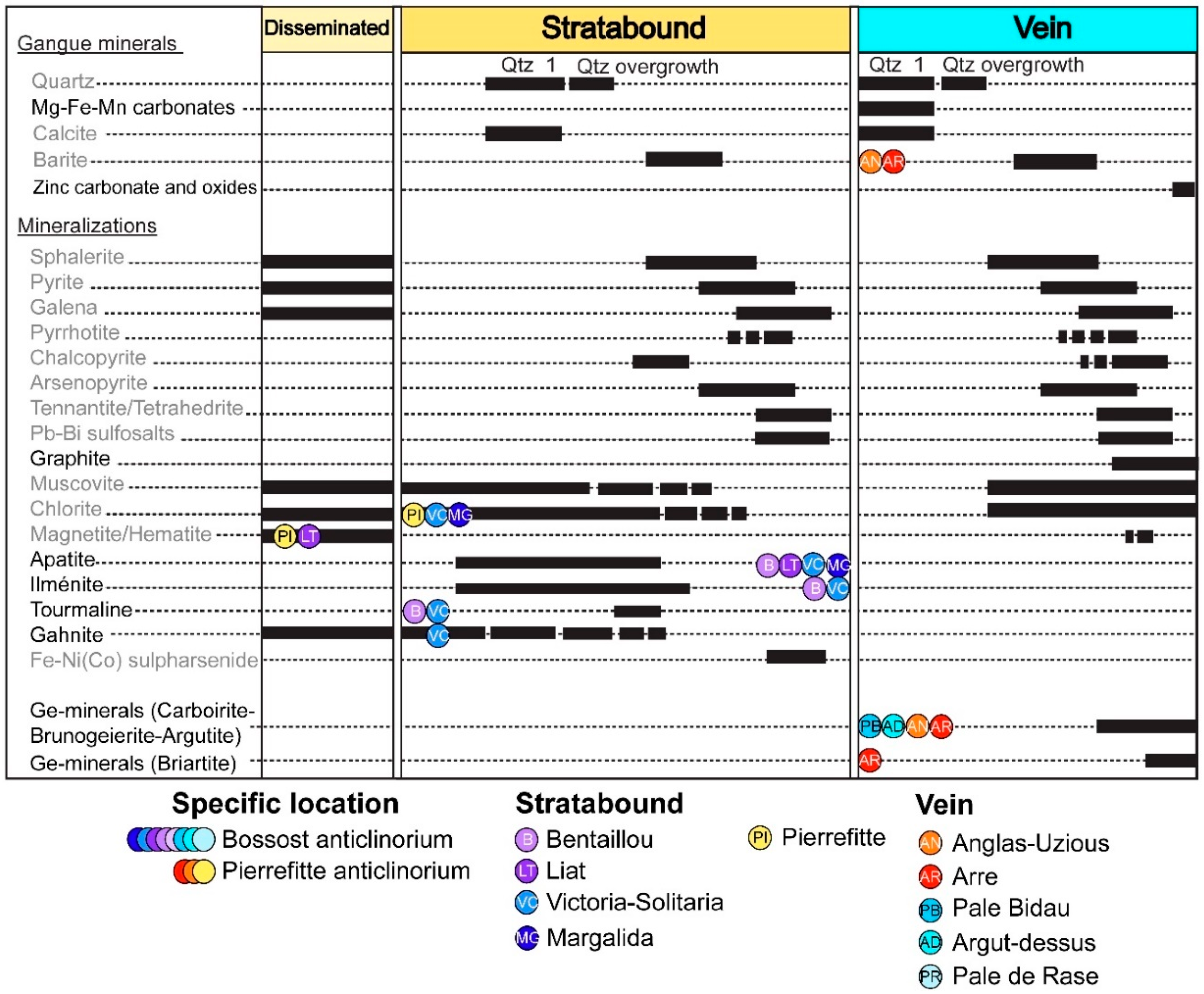
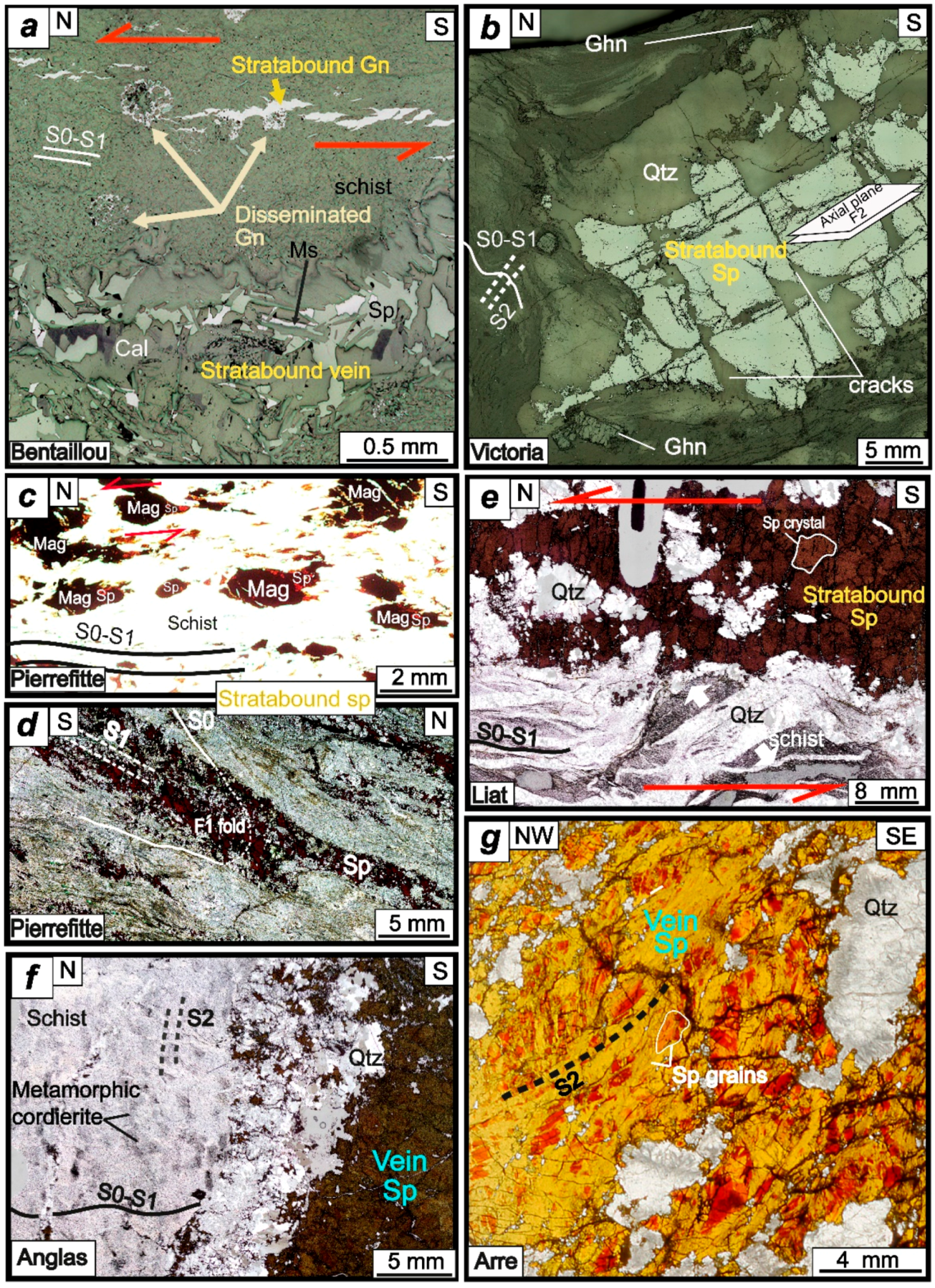
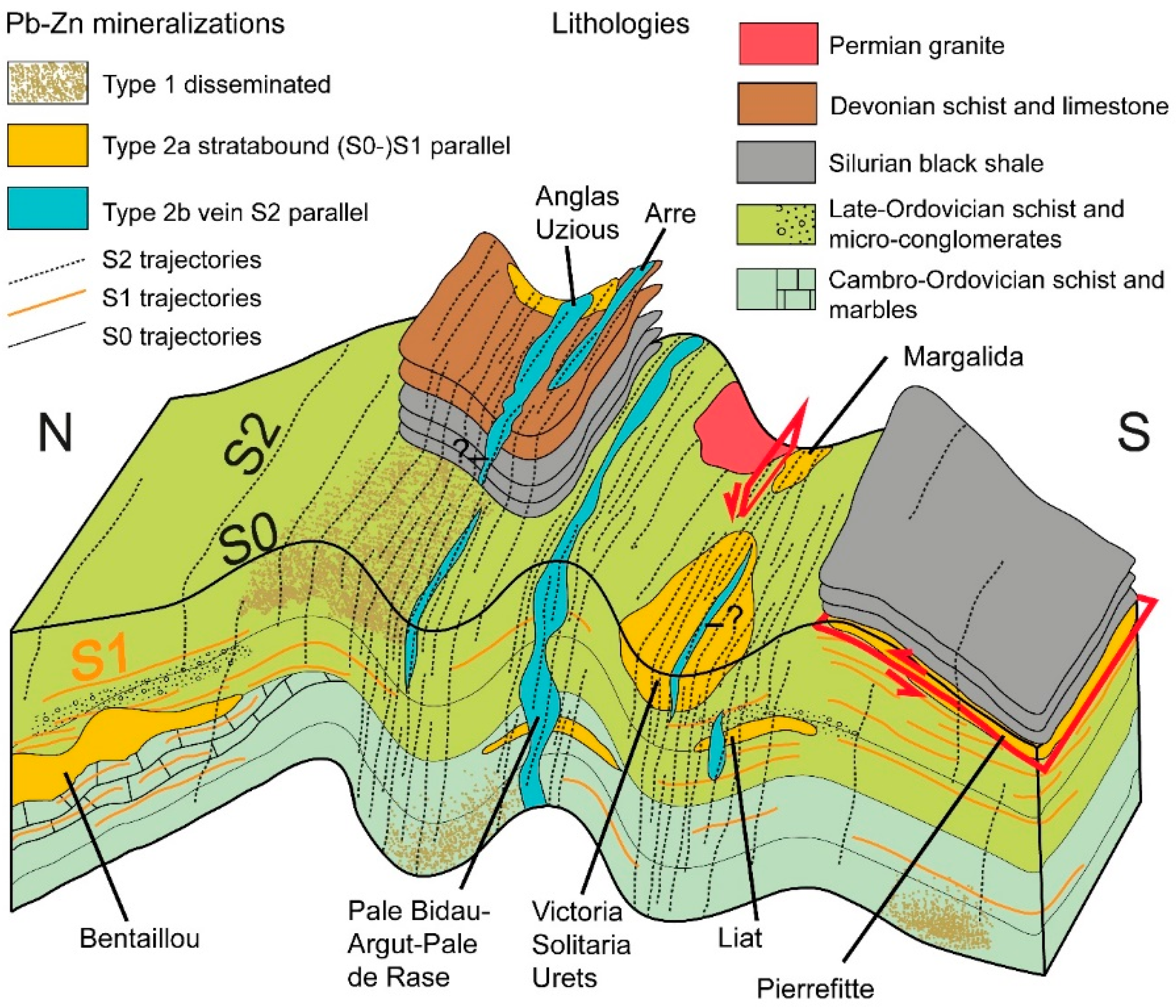
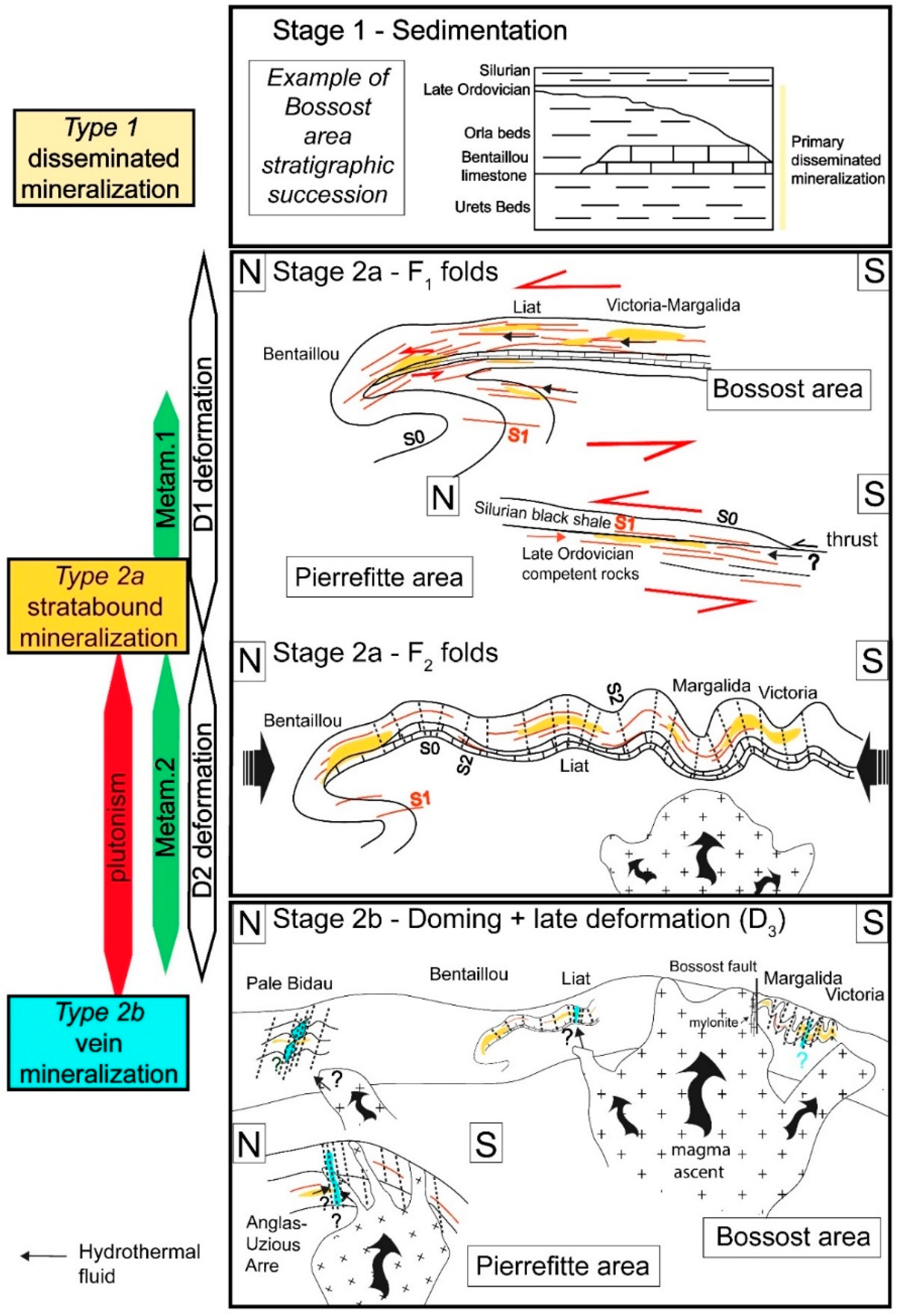
© 2018 by the authors. Licensee MDPI, Basel, Switzerland. This article is an open access article distributed under the terms and conditions of the Creative Commons Attribution (CC BY) license (http://creativecommons.org/licenses/by/4.0/).
Share and Cite
Cugerone, A.; Oliot, E.; Chauvet, A.; Gavaldà Bordes, J.; Laurent, A.; Le Goff, E.; Cenki-Tok, B. Structural Control on the Formation of Pb-Zn Deposits: An Example from the Pyrenean Axial Zone. Minerals 2018, 8, 489. https://doi.org/10.3390/min8110489
Cugerone A, Oliot E, Chauvet A, Gavaldà Bordes J, Laurent A, Le Goff E, Cenki-Tok B. Structural Control on the Formation of Pb-Zn Deposits: An Example from the Pyrenean Axial Zone. Minerals. 2018; 8(11):489. https://doi.org/10.3390/min8110489
Chicago/Turabian StyleCugerone, Alexandre, Emilien Oliot, Alain Chauvet, Jordi Gavaldà Bordes, Angèle Laurent, Elisabeth Le Goff, and Bénédicte Cenki-Tok. 2018. "Structural Control on the Formation of Pb-Zn Deposits: An Example from the Pyrenean Axial Zone" Minerals 8, no. 11: 489. https://doi.org/10.3390/min8110489
APA StyleCugerone, A., Oliot, E., Chauvet, A., Gavaldà Bordes, J., Laurent, A., Le Goff, E., & Cenki-Tok, B. (2018). Structural Control on the Formation of Pb-Zn Deposits: An Example from the Pyrenean Axial Zone. Minerals, 8(11), 489. https://doi.org/10.3390/min8110489





